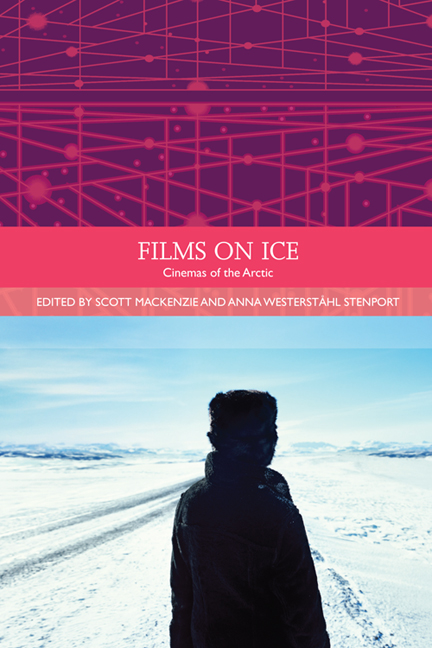Book contents
- Frontmatter
- Contents
- List of Illustrations
- Acknowledgements
- Traditions in World Cinema
- Introduction: What are Arctic Cinemas?
- PART I GLOBAL INDIGENEITY
- 1 ‘Who Were We? And What Happened to Us?’: Inuit Memory and Arctic Futures in Igloolik Isuma Film and Video
- 2 Northern Exposures and Marginal Critiques: The Politics of Sovereignty in Sámi Cinema
- 3 Frozen in Film: Alaska Eskimos in the Movies
- 4 Cultural Stereotypes and Negotiations in Sámi Cinema
- 5 Cinema of Emancipation and Zacharias Kunuk's Atanarjuat: The Fast Runner
- 6 Cosmopolitan Inuit: New Perspectives on Greenlandic Film
- 7 Arctic Carnivalesque: Ethnicity, Gender and Transnationality in the Films of Tommy Wirkola
- PART II HOLLYWOOD HEGEMONY
- PART III ETHNOGRAPHY AND THE DOCUMENTARY DILEMMA
- PART IV MYTHS AND MODES OF EXPLORATION
- Notes on the Contributors
- Index
1 - ‘Who Were We? And What Happened to Us?’: Inuit Memory and Arctic Futures in Igloolik Isuma Film and Video
from PART I - GLOBAL INDIGENEITY
Published online by Cambridge University Press: 05 September 2016
- Frontmatter
- Contents
- List of Illustrations
- Acknowledgements
- Traditions in World Cinema
- Introduction: What are Arctic Cinemas?
- PART I GLOBAL INDIGENEITY
- 1 ‘Who Were We? And What Happened to Us?’: Inuit Memory and Arctic Futures in Igloolik Isuma Film and Video
- 2 Northern Exposures and Marginal Critiques: The Politics of Sovereignty in Sámi Cinema
- 3 Frozen in Film: Alaska Eskimos in the Movies
- 4 Cultural Stereotypes and Negotiations in Sámi Cinema
- 5 Cinema of Emancipation and Zacharias Kunuk's Atanarjuat: The Fast Runner
- 6 Cosmopolitan Inuit: New Perspectives on Greenlandic Film
- 7 Arctic Carnivalesque: Ethnicity, Gender and Transnationality in the Films of Tommy Wirkola
- PART II HOLLYWOOD HEGEMONY
- PART III ETHNOGRAPHY AND THE DOCUMENTARY DILEMMA
- PART IV MYTHS AND MODES OF EXPLORATION
- Notes on the Contributors
- Index
Summary
INTRODUCTION
When Atanarjuat: The Fast Runner burst onto the international film scene in 2001 with its Camera d'Or win for director Zacharias Kunuk at Cannes, attention was suddenly focused on a small Inuit production company in the Canadian Eastern Arctic. Igloolik Isuma Productions, the world's first majority Inuit-owned independent film and video production company, was incorporated in 1990 and forced into bankruptcy in 2011. While to national and global audiences it may have seemed that Atanarjuat appeared from nowhere, the film was the cumulative result of Isuma's ten years of community-based film and video production in the Inuktitut language. The film represented a watershed for the company, marking a transition from its prior expertise in community video, television series and documentary film, to the creation of a critically successful and broadly popular full-length feature film. This chapter is an inquiry into Isuma's extensive film and video work. Focusing on specific productions, the chapter considers how Isuma's creative force reshaped dominant genres and conventions within an indigenous Arctic context. The company's unceasing commitment to Inuit language, local autonomy and indigenous cultural knowledge established a powerful mode of opposition to southern and non-Inuit media representations of indigenous peoples, while creating new visual languages and relations of production unique to the Arctic and Inuit context. During its twenty-oneyear history, Isuma strategically exploited Canadian film and television policies and funding programmes to actively decolonise media production in the Arctic.
IGLOOLIK ISUMA AND THEORETICAL APPROACHES TO INDIGENOUS FILM
Igloolik is a hamlet of 1,500 people – 94 per cent Inuit – located on an island in the Foxe Basin, just off the Melville Peninsula in the Qikiqtani or Baffin region of Nunavut (Nunavut Planning Commission 2013). This part of the Eastern Arctic was first exposed to southern media and television in the mid- 1970s when the Canadian government created a satellite infrastructure to distribute telecommunications and public and commercial broadcasting across Canada and throughout the North. Television was first introduced in larger Arctic communities to meet demands of southern administrators and resource companies. In 1975 and again in 1979, the residents of Igloolik voted against reception of satellite television in their community, because southern channels were completely devoid of Inuit and Inuktitut-language content.
- Type
- Chapter
- Information
- Films on IceCinemas of the Arctic, pp. 33 - 44Publisher: Edinburgh University PressPrint publication year: 2014



